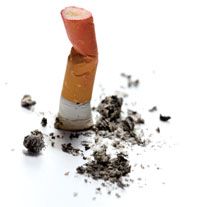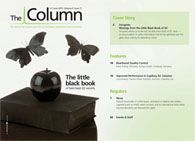Used butt not wasted
It is estimated that up to 4.5 trillion cigarette butts are stubbed, flicked and dropped every year. With few practical uses, any attempt at recycling the remains has been difficult; however a study published in Industrial & Engineering Chemistry Research proposes using them to prevent steel corrosion and could turn this trash into a tiny treasure.

It is estimated that up to 4.5 trillion cigarette butts are stubbed, flicked and dropped every year. With few practical uses, any attempt at recycling the remains has been difficult; however a study published in Industrial & Engineering Chemistry Research proposes using them to prevent steel corrosion and could turn this trash into a tiny treasure.1
Researchers in China studied the effect that extracts of cigarette butts in water would have on N80 steel, widely used in the oil industry, in hydrochloric acid. The corrosion of this steel under harsh conditions leads to costly damage and interuptions in production, which reported to cost oil producers millions of dollars annually. LC–MS was used on the butt water and was able to identify nine compounds, including nicotine, that help to inhibit metal corrosion. The inhibition efficiency of extracts in spectroscopic, polarization curve and weight loss studies confirmed this trend and showed that the efficiency was related to the concentration of butt water extracts.
The study suggests that the extracts may inhibit the corrosion via absorption into the metal surface, forming an oxidation film to protect the iron atoms from further dissolution.
1. Jun Zhao et al., Ind. Eng. Chem. Res., 49(8), 3986–3991 (2010).
This story originally appeared in The Column. Click here to view that issue.
New TRC Facility Accelerates Innovation and Delivery
April 25th 2025We’ve expanded our capabilities with a state-of-the-art, 200,000 sq ft TRC facility in Toronto, completed in 2024 and staffed by over 100 PhD- and MSc-level scientists. This investment enables the development of more innovative compounds, a broader catalogue and custom offering, and streamlined operations for faster delivery. • Our extensive range of over 100,000 high-quality research chemicals—including APIs, metabolites, and impurities in both native and stable isotope-labelled forms—provides essential tools for uncovering molecular disease mechanisms and exploring new opportunities for therapeutic intervention.
New Guide: Characterising Impurity Standards – What Defines “Good Enough?”
April 25th 2025Impurity reference standards (IRSs) are essential for accurately identifying and quantifying impurities in pharmaceutical development and manufacturing. Yet, with limited regulatory guidance on how much characterisation is truly required for different applications, selecting the right standard can be challenging. To help, LGC has developed a new interactive multimedia guide, packed with expert insights to support your decision-making and give you greater confidence when choosing the right IRS for your specific needs.

.png&w=3840&q=75)

.png&w=3840&q=75)



.png&w=3840&q=75)



.png&w=3840&q=75)










